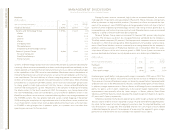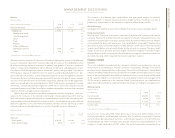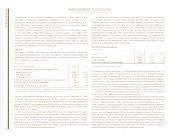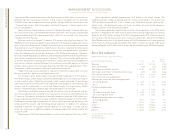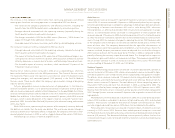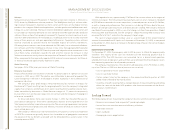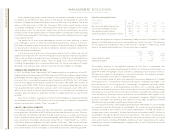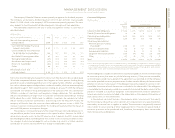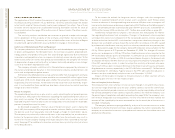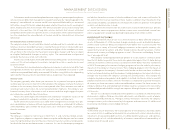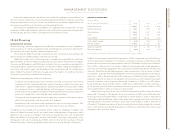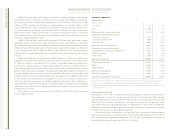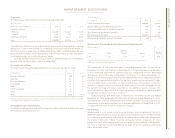IBM 2004 Annual Report Download - page 34
Download and view the complete annual report
Please find page 34 of the 2004 IBM annual report below. You can navigate through the pages in the report by either clicking on the pages listed below, or by using the keyword search tool below to find specific information within the annual report.
MANAGEMENT DISCUSSION
International Business Machines Corporation and Subsidiary Companies
32
ibm annual report 2004
critical accounting estimates
The application of GAAP involves the exercise of varying degrees of judgment. While the
resulting accounting estimates will, by definition, not always precisely equal the related
actual results, eight of these estimates involve more judgment than others. Two of these
estimates are the allowance for uncollectible financing receivables and the fair value of
lease residual values. See page 39 for a discussion of these estimates. The others are dis-
cussed below.
The sensitivity analyses used below are not meant to provide a reader with manage-
ment’s predictions of the variability of the estimates used. Rather, the sensitivity levels
selected (e.g., 5 percent, 10 percent, etc.) are included to allow users of the Annual Report
to understand a general-direction cause and effect of changes in the estimates.
Useful Lives of Microelectronics Plant and Equipment
The company determines the estimated useful lives and related depreciation charges for
its plants and equipment. For Microelectronics, this estimate is based on projected tech-
nology, process and product life cycles that could change significantly due to technical
innovations and competitor actions in response to relatively severe industry cycles. To the
extent actual useful lives are less than previously estimated lives, the company will increase
its depreciation charge or will write-off or writedown technically obsolete or non-strategic
assets that have been abandoned or sold.
The company estimates useful lives of its Microelectronics equipment by reference to
the current and projected dynamics in the semiconductor industry, product/process life
cycles and anticipated competitor actions.
To the extent that Microelectronics actual useful lives differ from management’s estimates
by 10 percent, consolidated net income would be an estimated $62 million higher/lower
based upon 2004 results, depending upon whether the actual lives were longer/shorter,
respectively, than the estimates. To the extent that the actual lives were shorter by 10 per-
cent, it is estimated that there would have also been a lower-of-cost-or-market inventory
charge of less than $5 million.
Pension Assumptions
The expected long-term return on plan assets is used in calculating the net periodic pension
(income)/cost. See page 83 for information regarding the expected long-term return on
plan assets assumption. The differences between the actual return on plan assets and
expected long-term return on plan assets are recognized in the calculation of net periodic
pension (income)/cost over five years.
As described on page 83, if the fair value of the pension plan’s assets is below the
plan’s ABO, the company will be required to record a minimum liability. In some situations,
the pension asset must be partially reversed through a charge to stockholders’ equity.
The company may voluntarily make contributions or be required, by law, to make contri-
butions to the pension plans. Actual results that differ from the estimates may result in
more or less future company funding into the pension plans than is planned by manage-
ment. See page 31 for additional information and near-term sensitivities of actual returns
on funding decisions.
To the extent the outlook for long-term returns changes such that management
changes its expected long-term return on plan assets assumption, each 50 basis point
increase or decrease in the expected long-term return on PPP plan assets assumption will
have an estimated increase or decrease, respectively, of $229 million on the following year’s
pre-tax net periodic pension income (based upon the PPP’s plan assets at December 31,
2004 and the January 2005 contribution of $1.7 billion discussed further on page 84).
Another key management assumption is the discount rate. See page 83 for informa-
tion regarding the discount rate assumption. Changes in the discount rate assumptions
will impact the interest cost component of the net periodic pension income calculation
and due to the fact that the ABO is calculated on a net present value basis, changes in the
discount rate assumption will also impact the current ABO. An increase in the ABO caused
by a decrease in the discount rate may result in a voluntary contribution to a pension plan.
As discussed on page 30, the company reduced the discount rate assumption for the
PPP by 25 basis points to 5.75 percent on December 31, 2004. This change will increase
pre-tax cost and expense in 2005 by $90 million. Had the discount rate assumption for the
PPP increased by 25 basis points on December 31, 2004, pre-tax cost and expense would
have decreased by $91 million in 2005. As mentioned above, changes in the discount rate
assumption will impact the ABO which in turn, may impact the company’s funding decisions
if the ABO exceeds plan assets. In order to analyze the sensitivity of discount rate move-
ments, each 25 basis point increase or decrease in the interest rate will cause a correspon-
ding decrease or increase, respectively, in the PPP’s ABO of an estimated $1.1 billion based
upon December 31, 2004 data. Page 82 presents the PPP’s ABO (after the reduction in
discount rate discussed above) and plan assets as of December 31, 2004.
Impacts of these types of changes on the pension plans in other countries will vary
depending upon the status of each respective plan.
Costs to Complete Service Contracts
The company enters into numerous service contracts through its SO and BCS businesses.
SO contracts range for periods up to ten years and BCS contracts can be for several years.
During the contractual period, revenue, cost and profits may be impacted by estimates of
the ultimate profitability of each contract, especially contracts for which the company uses
the percentage-of-completion method of accounting. See page 50 for the company’s serv-
ices revenue recognition accounting policies. If at any time, these estimates indicate the
contract will be unprofitable, the entire estimated loss for the remainder of the contract is
recorded immediately.
The company performs ongoing profitability analyses of its services contracts in order
to determine whether the latest estimates require updating. Key factors reviewed by the
company to estimate the future costs to complete each contract are future labor costs and
productivity efficiencies.


